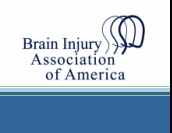
| About Brain Injury |
  |
||
Facts About Traumatic Brain Injury Click here for a PDF version of this fact sheet. If you don't have Acrobat Reader, you can download it for free by clicking on the icon below.
How many people have TBI? Of the 1.4 million who sustain a TBI each year in the United States:
The number of people with TBI who are not seen in an emergency department or who receive no care is unknown.
Blasts are a leading cause of TBI for active duty military personnel in war zones.2 Who is at highest risk for TBI?
What are the costs of TBI? Direct medical costs and indirect costs such as lost productivity of TBI totaled an estimated $60 billion in the United States in 1995.4 What are the long-term consequences of TBI? The Centers for Disease Control and Prevention estimates that at least 3.17 Million Americans currently have a long-term or lifelong need for help to perform activities of daily living as a result of a TBI.5
TBI can cause a wide range of functional changes affecting thinking, language, learning, emotions, behavior, and/or sensation. It can also cause epilepsy and increase the risk for conditions such as Alzheimer's disease, Parkinson's disease, and other brain disorders that become more prevalent with age.7,8 |
||
|


